Google Chromecast 2: Price, Release Date, Features and New Design

Google is taking the home entertainment experience to places it's never been. The search giant released Chromecast 2, a souped-up version of its original Chromecast content streamer, Tuesday at its fall keynote event with a noteworthy audio-related addition. The device went on sale Tuesday.
"What we were able to do was build a product that is extremely focused on delivering ... quality and performance from the cloud," Micah Collins, senior product manager of Chromecast, told TechCrunch. "Build the construct where apps could communicate with it. Apps wherever users are."
Here's what to expect with Google's Chromecast 2:
The upgrade: Chromecast, originally released in 2013, is a USB-like device that allows users to stream video from their smartphones or tablets to their TV screens. Now, with Chromecast 2, users can also use a similar device to stream audio from their smartphones or tablets to any speaker with an AUX port, TechCrunch reports. Time to dust off those old speakers.
The device works with the iPhone, iPad, Android devices, Chromebook, Mac and Windows laptops. Every feature available with Chromecast 2 works by downloading the app to your smartphone or tablet, meaning the mobile device is essentially the remote control.
Chromecast Audio: The concept of the Chromecast 2 audio device is similar to Sonos, the audio-streaming app that allows users to stream music from their smartphone to Sonos speakers. Google's goes a step further because users don't need to purchase Chromecast speakers to work the device (such speakers don't exist anyway.)
Price: Both the audio and video device are $35. Sonos costs at least $199, and a new Apple TV will run $139 or $199.
Chromecast audio works with apps including Pandora, iHeartRadio and Google Play Music, according to their website.
New design: The Chromecast 2 also got a design upgrade. The original Chromecast resembled a USB stick, while the new version of Chromecast is round and has a built-in HDMI cord. This makes it easier to plug the device into an HDMI port, Engadget reports. The device also comes with three Wi-Fi antennas and chooses the best one algorithmically. Google calls it an "adaptive antenna system," TechCrunch reports.